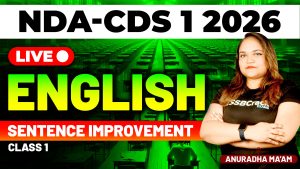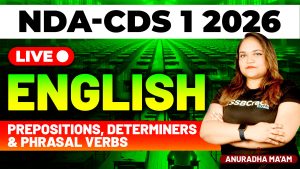Algebra is a core component of the Mathematics syllabus in the Combined Defence Services (CDS) Exam, requiring a thorough understanding of concepts and a logical approach to problem-solving. A recent class focused on foundational and advanced algebraic topics such as linear equations, simultaneous linear equations, consistent and inconsistent systems of equations, quadratic equations, and their related properties. Here’s a detailed recap of the class and strategies to prepare these topics effectively for the CDS Exam.
Topics Covered in the Class
1. Linear Equations
The class began with the fundamentals of linear equations, which are equations involving variables raised to the first power. These equations are foundational for understanding algebra and often appear in the exam as straightforward problem-solving questions.
2. Simultaneous Linear Equations
Next, simultaneous linear equations were discussed. These involve solving two or more linear equations with multiple variables. The class explored various methods to solve such equations, including:
- Substitution method.
- Elimination method.
- Graphical representation to understand the intersection of lines as a solution.
3. Consistent and Inconsistent Systems of Equations
Students were introduced to the concepts of consistency in systems of equations:
- Consistent System: Equations that have at least one solution.
- Inconsistent System: Equations with no solution.
The importance of identifying these characteristics was emphasized as they form a crucial part of analytical reasoning in algebra.
4. Quadratic Equations
The session progressed to quadratic equations, which involve variables raised to the second power. The following sub-topics were discussed:
- Roots of Quadratic Equations: Solutions that satisfy the equation.
- Discriminant: A tool to determine the nature of roots (real, imaginary, or equal).
- Quadratic Formula: A universal method for solving quadratic equations.
- Relation Between Roots and Coefficients: Understanding how the sum and product of roots relate to the coefficients of the equation.
Key Takeaways from the Class
- Building a Strong Conceptual Foundation
The class emphasized understanding the basic principles behind each type of equation, ensuring students could solve problems systematically. - Problem-Solving Techniques
Different approaches to solving equations, such as substitution, elimination, and the quadratic formula, were demonstrated with practical examples. - Real-World Applications
Students were shown how these concepts are not only relevant for exams but also applicable to real-world scenarios, enhancing their interest and engagement. - Focus on Common Pitfalls
The instructor highlighted common errors, such as misinterpreting the discriminant or incorrect application of formulas, helping students avoid such mistakes in the future.
Strategies to Prepare Algebra for the CDS Exam
1. Understand the Basics Thoroughly
- Learn the definitions and properties of linear and quadratic equations.
- Practice identifying consistent and inconsistent systems to build analytical skills.
2. Practice Different Methods
- Familiarize yourself with various methods of solving simultaneous equations.
- Ensure you can use the quadratic formula efficiently under timed conditions.
3. Memorize Key Properties
- Focus on the relation between roots and coefficients for quadratic equations.
- Remember the conditions indicated by the discriminant and their implications for the nature of roots.
4. Solve Previous Year Questions
- Regular practice of past CDS exam questions will give insight into frequently asked patterns and help in time management.
5. Take Timed Mock Tests
- Simulate exam-like conditions to practice solving algebra questions under pressure.
- Analyze your performance to identify strengths and areas that need improvement.
6. Focus on Accuracy
- Ensure calculations are precise, as small errors can lead to incorrect answers.
- Review solutions to understand the logic behind each step.
7. Use Visual Aids
- Graphical representation of equations helps in better understanding and cross-verification of solutions.
Common Mistakes to Avoid
- Skipping Conceptual Understanding
- Memorizing formulas without understanding their derivation and application often leads to errors.
- Ignoring Practice
- Lack of regular practice can result in slower problem-solving during the exam.
- Overlooking Special Cases
- Pay attention to unique scenarios, such as equations with no solution or those with infinitely many solutions.
- Rushing Through Problems
- Take your time to read and understand each question properly to avoid misinterpretation.
Conclusion
The recent class on algebra provided a well-rounded approach to mastering linear and quadratic equations, emphasizing theoretical understanding and practical problem-solving skills. These topics, being integral to the CDS Exam syllabus, require consistent practice, attention to detail, and a strategic approach.
By focusing on the concepts discussed, practicing extensively, and analyzing mistakes, students can significantly improve their proficiency in algebra. With dedication and the right preparation strategies, tackling algebra questions in the CDS Exam becomes manageable and rewarding.
Stay focused, practice diligently, and approach each problem with confidence. Algebra can be one of your strongest scoring areas with the right preparation!



















